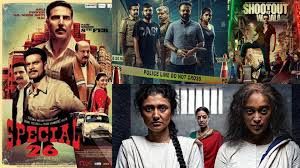Indian cinema, long renowned for its song-and-dance spectacles and weepy melodramas, is undergoing a seismic shift. Increase in crime thrillers This marks a departure of sorts in terms of structure, narrative styles and what the viewer expects out of his viewing experience. Driven by the need for some realism, a bit of complexity and a lot of edge-of-the-seat who-done-it, Indian film makers are dishing out narratives that are not just entertaining but provoke the viewer’s intellect as well. In this article, we explore how crime thrillers are changing the game of Indian storytelling, how influences are divided between Bollywood and Hollywood, and how the situation stands.
A Genre Reborn: The Evolution of Crime Thrillers in Indian Cinema
Crime thrillers in India are not altogether a new territory. Classics from those early years like Gumnaam (1965), Teesri Manzil (1966) and Jewel Thief (1967) offered glimmers of what the genre was capable of. But beyond that, it took a little more time until roughly the 2000s for the genre to start growing a unique-voiced set of legs. Films such as A Wednesday (2008) Talaash (2012) and Kahaani (2012) marked a new age for storytelling where intricate plotlines, layered psychology and narrative twists were made a priority.
Key Drivers of the Genre’s Popularity
- Changing Audience Preferences: Today’s viewers demand intelligent content that offers more than just surface-level entertainment.
- Streaming Platforms: Netflix, Amazon Prime, and others have provided a platform for bolder, more experimental stories.
- Globalization: Exposure to international content has influenced audience taste and inspired Indian creators to raise the bar.
The Anatomy of Indian Crime Thrillers
What sets Indian crime thrillers apart is their unique blend of cultural relevance, character-driven plots, and suspenseful storytelling.
Cultural Context and Realism
Unlike their Western counterparts, Indian crime thrillers often root their narratives in local socio-political landscapes. Whether it’s the caste dynamics in Article 15 (2019) or systemic corruption in Drishyam (2015), these films use crime as a lens to explore broader societal issues.
Complex Characters and Moral Ambiguity
Gone are the days of clear-cut heroes and villains. Today’s thrillers often feature flawed protagonists and morally grey situations, as seen in Andhadhun (2018) and Raat Akeli Hai (2020).
Innovative Storytelling Techniques
Indian filmmakers are increasingly experimenting with non-linear narratives, unreliable narrators, and twist endings, keeping viewers constantly guessing.
Bollywood vs. Hollywood: How Thrillers Borrow and Adapt Stories
The influence of Hollywood on Indian crime thrillers is undeniable, but Bollywood has also brought its unique spin to the genre.
Inspiration vs. Imitation
While films like Badla (2019) draw directly from Spanish thriller The Invisible Guest, others like Kahaani innovate with original plots that rival Western counterparts in complexity and suspense.
Style and Aesthetic
Hollywood thrillers often rely on high-tech gadgetry and sleek cinematography. Indian thrillers, meanwhile, lean heavily into atmospheric tension, urban decay, and culturally grounded storytelling.
Narrative Structure
Hollywood tends to favor fast-paced plots and closed endings. Indian thrillers often take their time to build suspense and leave room for interpretation.
The Role of Technology: From Filmmaking to Marketing
The rise of AI, data analytics, and automation is reshaping not just the stories being told, but how they are made and marketed.
AI in Screenwriting and Plot Prediction
Data-driven tools are helping writers understand what types of plot twists resonate most with audiences.
Predictive Analytics in Marketing
Streaming platforms use algorithms to push crime thrillers to viewers most likely to engage with them, increasing their visibility and success.
Audience Feedback Loops
Real-time data from platforms like YouTube and Twitter inform filmmakers on audience reactions, helping refine scripts and characters.
Notable Crime Thrillers That Redefined Indian Storytelling
Drishyam (2015)
A masterclass in misdirection, Drishyam kept audiences guessing till the very end.
Andhadhun (2018)
Combining black comedy with nail-biting suspense, this film broke genre boundaries.
Kahaani (2012)
With a pregnant protagonist navigating the streets of Kolkata, Kahaani delivered one of the most unexpected climaxes in Indian cinema.
Ratsasan (2018, Tamil)
A psychological thriller that has earned cult status for its gripping portrayal of a serial killer on the loose.
The Future of Indian Crime Thrillers
With the advent of advanced storytelling tools and evolving viewer expectations, the genre is poised for even greater heights.
Integration of AI and Automation in Production
Tools like deepfake technology and virtual cinematography can revolutionize how thrillers are shot and edited.
Regional Cinema’s Rise
Regional films like Ratsasan and Mumbai Police (Malayalam) are gaining national and international acclaim, pushing the boundaries of what’s possible.
More Crossovers and Collaborations
Expect to see more Indo-Western collaborations and adaptations that blend global storytelling techniques with local flavor.
The recent flood of crime movies in Indian cinema is about more than a move in genre pecking order. It’s an indication of a maturing audience, a braver filmmaking community and an industry that is ready to compete on the world stage. With the advent of AI, data analytics, and streaming platforms, Indian crime thrillers are not only here to stay they’re primed for domination.
FAQs
What defines a crime thriller in Indian cinema?
A crime thriller typically involves a suspenseful plot centered around a crime, investigation, or mystery, often layered with psychological tension and societal commentary.
Are Indian crime thrillers suitable for international audiences?
Absolutely. Many Indian thrillers like Andhadhun and Drishyam have universal themes and are even being remade in other languages.
How are streaming platforms influencing crime thrillers?
They allow for more experimental storytelling, reaching niche audiences without the constraints of box office pressure.
What are some must-watch Indian crime thrillers?
Kahaani, Andhadhun, Drishyam, Ratsasan, and Talaash are excellent starting points.
Will AI and data analytics change how thrillers are made?
Yes. These technologies can optimize scriptwriting, predict audience engagement, and even personalize content delivery.
